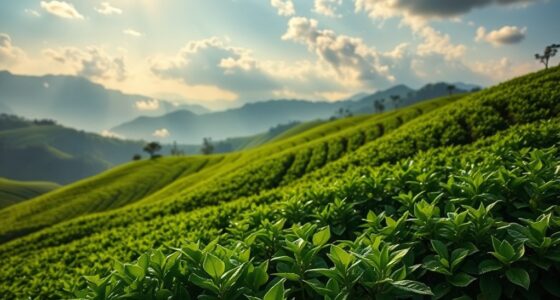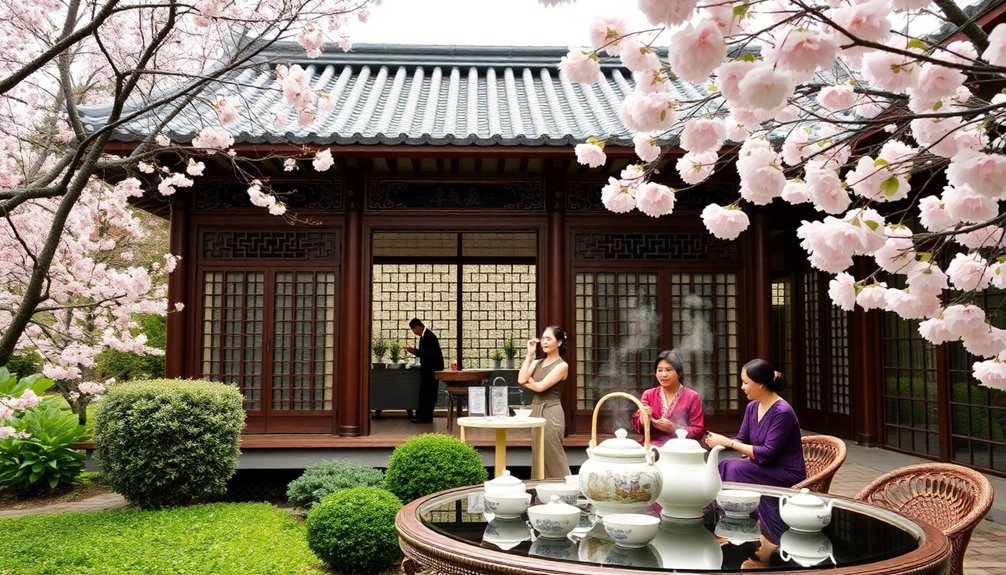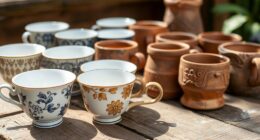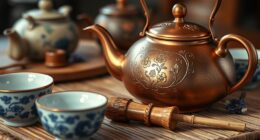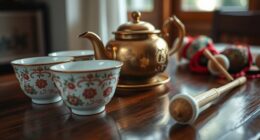Chinese tea differs from other teas through its rich history, cultural significance, and traditional processing techniques that preserve natural flavors. It often involves minimal processing, emphasizing regional terroirs like Longjing or Yunnan, which shape unique profiles. Unlike some teas globally, Chinese varieties focus on craft, mindfulness, and history, making each cup a cultural experience. If you want to uncover more about what makes Chinese tea so special, continue exploring its fascinating world.
Key Takeaways
- Chinese teas often undergo less processing, preserving natural flavors and health benefits compared to more heavily processed teas globally.
- Traditional Chinese techniques like gongfu brewing emphasize mindfulness and artistry, differing from modern commercial methods elsewhere.
- Regional terroirs in China create distinct flavor profiles, such as Longjing’s mineral notes or Yunnan’s earthy tones, reflecting local environments.
- Chinese tea culture deeply integrates social rituals and history, elevating tea from a beverage to an art form, unlike some other cultures’ more casual tea practices.
- Compared to globally mass-produced teas, Chinese teas emphasize quality, regional variation, and cultural heritage, offering a more authentic and meaningful experience.

Chinese tea has a rich history that sets it apart from other teas around the world, offering unique flavors, processing methods, and cultural significance. When you explore Chinese teas, you quickly realize that their distinct characteristics stem from centuries of tradition, especially in tea cultivation techniques. Chinese tea farmers use specific methods to guarantee the quality and flavor of their teas, such as hand-picking leaves during ideal seasons and employing traditional processing techniques like pan-firing or steaming. These methods not only preserve the delicate taste but also contribute to the unique profiles of each tea type, whether it’s the light, floral notes of a green tea or the robust, earthy flavors of a pu-erh.
Chinese tea’s rich history and traditional cultivation techniques create unique flavors and cultural significance.
Beyond cultivation, the cultural significance of Chinese tea is deeply woven into the fabric of daily life and social rituals. Drinking tea isn’t just about the beverage itself; it’s about honoring history, hospitality, and harmony. Tea ceremonies, which vary by region, highlight this importance, emphasizing respect, mindfulness, and connection. You might participate in a gongfu tea ceremony, where every step—from selecting leaves to pouring water—is performed with precision and reverence. This cultural dimension elevates Chinese tea from a simple drink to an art form that embodies centuries of tradition.
In contrast to many other teas around the world, Chinese teas often undergo minimal processing, which helps retain their natural characteristics. For example, green teas are usually steamed or pan-fired shortly after harvest to lock in freshness and flavor, while black teas undergo full oxidation to develop a richer, deeper taste. The emphasis on traditional techniques means that each batch reflects the specific terroir of its region, such as the mineral-rich slopes of Longjing or the humid forests of Yunnan. This regional variation adds to the cultural significance, making each tea a reflection of its origin.
Additionally, the emphasis on traditional processing techniques helps preserve the natural qualities of Chinese teas, allowing them to maintain their distinctive flavors and health benefits. When you compare Chinese tea to others, you’ll notice that the focus on cultivating techniques and cultural practices creates a more intimate and meaningful experience. It’s not just about the taste but also about understanding the history and appreciation embedded in every sip. This deep connection to cultural roots ensures that Chinese tea remains a unique and revered part of the world’s tea heritage, offering more than just flavor—it offers a glimpse into a centuries-old tradition that continues to thrive today.
Frequently Asked Questions
How Does Chinese Tea Influence Traditional Chinese Medicine Practices?
You should know that Chinese tea considerably influences traditional Chinese medicine practices through its herbal properties and medicinal uses. It’s often used to balance energy, improve digestion, and detoxify the body. Different teas like green, black, and oolong are valued for their specific health benefits, helping to treat various ailments. By incorporating Chinese tea into daily routines, you can support overall well-being and harmony within your body’s systems.
What Are the Environmental Impacts of Chinese Tea Cultivation Compared to Others?
You’ll find that Chinese tea cultivation often emphasizes sustainable farming practices, which help reduce environmental impacts. Compared to other teas, it usually requires less water, thanks to traditional methods that conserve resources. This approach minimizes soil degradation and supports biodiversity. By choosing Chinese teas grown with sustainable practices, you help promote eco-friendly farming, ensuring the environment is protected while enjoying your favorite tea.
Are There Specific Chinese Teas Recommended for Health Benefits?
You’ll want to try green tea, especially varieties like Longjing, for their legendary health benefits. These teas boast potent antioxidant properties that promote wellness. Herbal infusions like Chrysanthemum or Goji berry also deliver specific health perks, from soothing stresses to boosting immunity. By choosing these Chinese teas, you harness healing herbs and antioxidants that can support your health goals naturally and effectively, making each sip a small step toward wellness.
How Do Chinese Tea Harvesting Techniques Differ From Those Elsewhere?
You’ll notice Chinese tea harvesting techniques differ through their unique harvesting methods and plucking techniques. In China, farmers often use selective plucking, choosing only the young, tender leaves and buds by hand to guarantee quality. They may harvest multiple times a year, depending on the region and tea type. This careful approach contrasts with machine harvesting elsewhere, emphasizing tradition and precision to produce high-quality teas.
What Cultural Ceremonies Are Associated With Chinese Tea Consumption?
Like a delicate dance, Chinese tea ceremonies embody rich cultural traditions. You observe specific tea etiquette, such as precise pouring and mindful sipping, during ceremonial rituals like Gongfu Cha. These rituals emphasize respect, harmony, and mindfulness, transforming tea drinking into an art form. Participating in these ceremonies, you connect deeply with Chinese history and philosophy, making each cup a meaningful experience beyond just taste.
Conclusion
Ultimately, Chinese tea charms with its cultural character, complex craftsmanship, and comforting cadence. By comparing it to other teas, you discover diverse delights and distinctive depths. Whether you savor subtle serenity or bold brilliance, Chinese tea’s charm captivates. So, sip, savor, and see the subtle, soulful similarities and striking differences. Chinese teas truly teach you to treasure tradition, taste, and time—turning every teacup into a timeless treasure.



